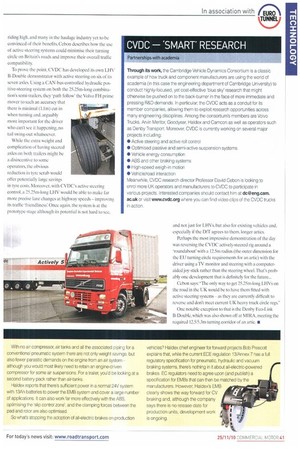HALDEX ELECTRIC BRAKES IN ACTION
Page 40

Page 41

If you've noticed an error in this article please click here to report it so we can fix it.
Truck and trailer makers have been talking about all-electric braking systems for many years, but until now there's been little to show for it in terms of working hardware. However, at the recent CVDC open day, Haldex showed off, to great effect on a rain-lashed Ml RA test track, a tractor with its Electro-Mechanical Brakes (EMB) system. The Haldex FMB Volvo has dual-circuit, brushless DC motors at each wheel hub that push the brake pad onto the disc, as well as applying the spring parking-brake, all controlled by an ECU within each wheel unit. What makes the Haldex demonstrator interesting is the fact that, in the past, prototype electric brake installations have usually featured redundant back-up air systems retained on the vehicle — but not on the Haldex Volvo. The benefits of all-electric brakes include a much faster reaction time between the driver pushing the brake pedal and the brakes actually being applied, not least because you don't need to wait for air to be released via solenoids into the conventional air brake chambers, etc.
The faster you apply the brakes, the quicker you can stop, and the shorter the overall braking distances. On the very wet MIRA braking track, the EMB tractor stopped steadily in a noticeably shorter distance, on a variety of friction surfaces, than a conventional EBS/ABS tractor.
With no air compressor, air tanks and all the associated piping for a conventional pneumatic system there are not only weight savings, but also fewer parasitic demands on the engine from an air system although you would most likely need to retain an engine-driven compressor for some air suspensions. For a trailer, you'd be looking at a second battery pack rather than air-tanks.
Haldex reports that there's sufficient power in a normal 24V system with 13Ah batteries to power the EMB system and cover a large number of applications. It can also work far more effectively with the ABS, optimising the 'slip control zone', and the clamping forces between the pad and rotor are also optimised.
So what's stopping the adoption of all-electric brakes on production
vehicles? Haldex chief engineer for forward projects Bob Prescott explains that, while the current ECE regulation 13/Annex 7 has a full regulatory specification for pneumatic, hydraulic and vacuum braking systems, there's nothing in it about all-electric-powered brakes. EC regulators need to agree upon (and publish) a specification for EMBs that can then be matched by the manufacturers. However, Haldex's EMB clearly shows the way forward for CV braking and, although the company says there is no release date for production units, development work is ongoing.




































































































































